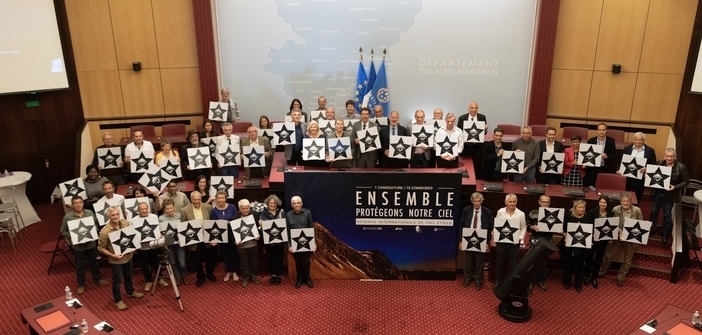This Monday, Charles Ange Ginésy, President of the Alpes-Maritimes Department, President of the Alpes d’Azur Community of Communes, and President of the Mercantour National Park, alongside Eric Mele, President of the Préalpes d’Azur Regional Natural Park, Mayor of Gourdon, and the Mayors of the concerned municipalities, presented the application for the “International Dark Sky Reserve” label.
It is estimated today that 80% of the world’s population no longer has access to the starry sky that has inspired and fueled humanity’s imagination for centuries. In the department, the quality of the night sky attracts many astronomers and constellation enthusiasts. Even though the coast suffers from severe light pollution, nearly 3,000 stars can be observed in the heart of the Mercantour Park. To undertake an action to protect biodiversity, the elected officials voted this Tuesday for the application for the “International Dark Sky Reserve” label, which would make Alpes-Maritimes the first RICE in the Southeast of France and the third in the country if approved.
This label is awarded by the International Dark-Sky Association (IDA) based in the United States and is particularly demanding. Its primary objective is to combat light pollution, a real scourge for many animal species, such as insects and bats. Artificial light causes disorientation, collisions, and even disrupts the migrations and reproduction of these animals.
The area concerned by the RICE covers 2300km2 and encompasses 75 municipalities with a total of 55,000 inhabitants. It spans around the Mercantour National Park, the Préalpes d’Azur Regional Natural Park, and the Alpes d’Azur Community of Communes. By 2025, more than 50% of light points within the potential RICE are expected to be renovated.
Several projects are already under consideration, in anticipation of the labeling of this territory:
– Renovation of public lighting (warm colors, redirecting lights to the ground)
– Support for tourism stakeholders to develop astro- and eco-tourism offerings
– New outdoor projects to facilitate star observation
– Creation of a planetarium and new educational, awareness, and discovery initiatives about the nocturnal world for both young and old.
From a biodiversity perspective, the project would potentially protect iconic species such as the Tengmalm’s Owl or the Bombyx of the Mercantour. The IDA’s response will be announced at the end of the year.


